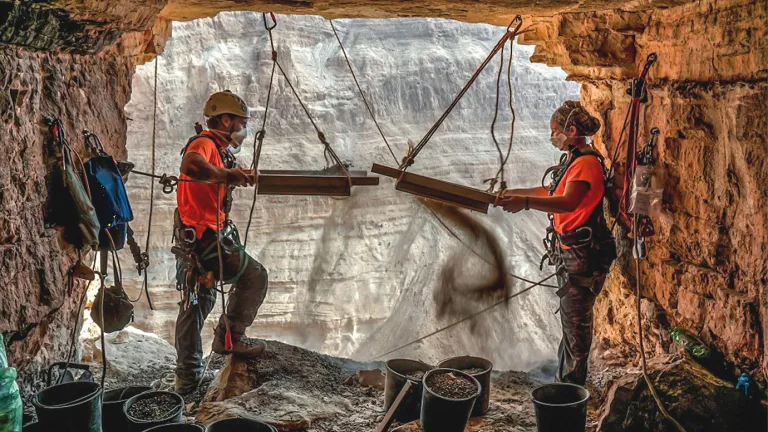God, Science and the Bible: Discoveries at Goliath's hometown support accuracy of the Bible

This summer two significant discoveries at Tell es-Safi, identified as the site of biblical Gath, have been announced that support the historical accuracy of the Bible.
Bible critics have long dismissed its stories as myths, fables written centuries after they were claimed to have occurred. Yet time and time again, as reported in The Good News, significant details have come to light that illuminate and support the biblical record. This summer two significant discoveries at Tell es-Safi, identified as the site of biblical Gath, have been announced that support the historical accuracy of the Bible.
Gath is one of the largest tells (mounds formed from successive building over the ruins of ancient cities) in Israel. In Old Testament times it was one of the principal cities of the Philistines, enemies of the Israelites. Located about halfway between Jerusalem and the coastal city of Ashkelon (once Philistine as well), Gath is described in the Bible as being the hometown of Goliath, the giant slain by David.
This summer, archaeologists excavating the site uncovered the remains of what they have identified as a temple. Within it they found bases to support two large pillars, which in turn would've supported the entire structure. Why would this be significant?
You may recall the account of mighty Samson, who, as we read in the Bible, was a man of legendary strength and exploits against the Philistines. Deceived, taken prisoner and blinded by them, he was put to work like an ox or donkey grinding grain. Samson's death is memorialized in Judges 16:23-30:
"Now the lords of the Philistines gathered together to offer a great sacrifice to Dagon their god, and to rejoice . . . So it happened, when their hearts were merry, that they said, 'Call for Samson, that he may perform for us.' So they called for Samson from the prison, and he performed for them. And they stationed him between the pillars . . .
"And Samson took hold of the two middle pillars which supported the temple, and he braced himself against them, one on his right and the other on his left. Then Samson said, 'Let me die with the Philistines!' And he pushed with all his might, and the temple fell on the lords and all the people who were in it. So the dead that he killed at his death were more than he had killed in his life."
Bible critics long dismissed the story, claiming that temples in the Middle East weren't constructed with a pair of pillars supporting the structure. Yet now they are confronted with clear evidence that Philistine temples were constructed exactly that way!
In fact, this is now the third Philistine temple excavated in Israel—and all three show that they had two main pillars supporting a roof!
The first such temple was excavated in the 1970s near what is now Tel Aviv. There archaeologist Amihai Mazar found two column bases close enough together that a man could reach both pillars at once, exactly as described in the account of Samson's death. Then in the 1990s, archaeologist Trude Dothan excavated another temple at the Philistine city of Ekron featuring the same design.
While no one is claiming that any of these three temples is the one where Samson literally "brought down the house"—that happened at the Philistine city of Gaza, unexcavated because it lies underneath a modern city—these finds are nonetheless important in supporting the historical accuracy of the Bible record.
Archaeologist Bryant Wood explained their significance in a 1974 edition of Bible and Spade: "The pillars were made of wood and rested on stone support bases. With the pillars being about six feet apart, a strong man could dislodge them from their stone bases and bring the entire roof crashing down. The archaeological findings match the Biblical story perfectly and attest to the plausibility of the account . . .
"The Bible writer knew his facts. He knew that Philistine temples were supported by two pillars and that this was how Samson pulled the temple down. The report is that of an eye-witness, again demonstrating that indeed the Bible is the world's most accurate textbook" ("Samson and the Temple of Dagon," pp. 53-54).
Excavators at Gath also found evidence of another event recorded in the Bible—a major earthquake that occurred during the reign of Judah's King Uzziah around 750 B.C., mentioned in Amos 1:1 and Zechariah 14:5. Surprisingly, Zechariah wrote more than two centuries after the former quake happened. So it must have been a monumental event for it to have remained so long in the national consciousness!
Concerning the excavation of Gath, according to The Jerusalem Post: "Seismologists who examined the site confirmed that a major earthquake occurred there, one that they estimated would have measured 8 on the Richter scale. The main evidence was the presence of several brick walls that had been thrown apart and had collapsed 'like a deck of cards.'
"'If the seismologists are right, an 8 on the Richter scale would have leveled a major city. The intensity of the energy required to move the walls seem to have been from something very powerful,' [Bar Ilan University excavation director Aren] Maeir said . . .
"'What we have here is very strong arch-evidence of a dramatic earthquake, a natural event that left a very significant impression on the biblical prophets of the time" (Ben Hartman, "Temple Found in Philistine Home of Goliath," July 29, 2010).
Indeed, Gath is only the latest place that proof of this quake has been found. It was evidently a region-wide event. Researchers writing in the scientific journal International Geology Review reported back in July 2000:
"Widely separated archaeological excavations in Israel and Jordan contain late Iron Age . . . architecture bearing evidence of a great earthquake. Masonry walls best display the earthquake, especially walls with broken ashlars [large, rectangular stones], walls with displaced rows of stones, walls still standing but leaning or bowed, and walls collapsed with large sections still lying course-on-course.
"Debris at six sites (Hazor [in northern Israel], Deir 'Alla [in northwestern Jordan], Gezer, Lachish [both near Jerusalem], Tell Judeideh [in northern Syria], and 'En Haseva [south of the Dead Sea]) is tightly confined stratigraphically to the middle of the eighth century B.C. . . . Biblical and post-biblical sources indicate a single, regionally extensive earthquake in the year 750 B.C. . . .
"The earthquake was at least magnitude 7.8, but likely was 8.2 . . . [It] appears to be the largest yet documented on the Dead Sea transform fault during the last four millennia" (Steven Austin, Gordon Franz and Eric Frost, "Amos's Earthquake: An Extraordinary Middle East Seismic Event of 750 B.C.," Vol. 42, p. 657).
It should be further pointed out that the Gath excavation has also yielded other significant discoveries, including evidence of the earliest known Philistine settlement in the area and evidence of the city's destruction at the hands of Hazael, king of Syria, another figure mentioned in the Bible (2 Kings 12:18). For much more evidence of the accuracy of Scripture, send for or download our free booklet Is the Bible True?.
Excavations will continue at Gath in July 2011, and volunteers are welcomed. More information on the project, including how to volunteer, can be found at www.dig-gath.org and http://gath.wordpress.com. GN







